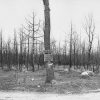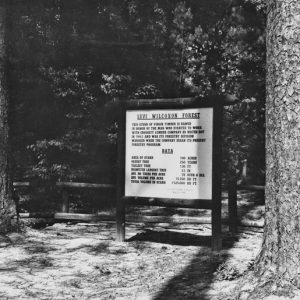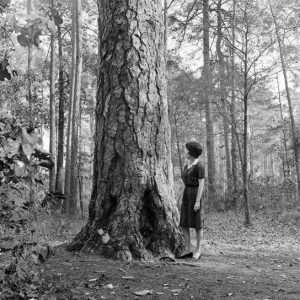calsfoundation@cals.org
Levi Wilcoxon Demonstration Forest
The Levi Wilcoxon Demonstration Forest (LWDF) is located about three miles south of Hamburg (Ashley County) along U.S. Highway 425. Privately owned, the LWDF is a remnant of the old-growth pine forest that once covered much of southern Arkansas. The LWDF is notable for the dimensions of the loblolly and shortleaf pines still found within its boundaries—most of the pines in this roughly ninety-acre stand are between 100 and 200 years old and over 100 feet tall. For example, the “Morris Pine” is a loblolly fifty-six inches in diameter, 117 feet tall, and estimated to be at least 300 years old. The national champion shortleaf is also found in the LWDF and measures thirty-six inches in diameter and 136 feet tall. Perhaps as notable as the size of the trees is the unique history of this parcel, starting with its namesake, Levi Roderick Wilcoxon.
Levi Wilcoxon was a local boy, born in 1884 and raised in the community of Berea (Ashley County). After studying at Beauvoir College in Wilmar (Drew County), the seventeen-year-old Wilcoxon was hired to carry water for the Crossett Lumber Company in July 1902. Over the years, Wilcoxon advanced in the company, becoming the logging superintendent, supervisor of Crossett Lumber Company’s lumber camps, and eventually the manager of its forestry division. It was in this capacity that, in 1939, Wilcoxon set aside a 100-acre parcel of the Crossett Lumber Company’s lands south of Hamburg along what was then known as the Bastrop Highway. This action protected an example of the rapidly disappearing virgin pine timber in Arkansas. Later, the Crossett Lumber Company honored Wilcoxon’s years of service by naming this stand the “Levi Wilcoxon Forest” in a formal ceremony on May 27, 1948.
According to a sign erected at this dedication, an average acre of this stand had seventy-eight pines that were greater than six inches in diameter, containing 15,000 total board feet of lumber. This stand was labeled a “demonstration forest” to exemplify what an uncut virgin pine stand looked like, compared to an “experimental forest,” which would have implied the deliberate manipulation of one or more forest conditions in a replicated (scientific) fashion.
Over the years, the LWDF served as a picnic area for travelers and was a frequent stop for visiting foresters and other interested parties. Its designation did not change in 1962 when Georgia-Pacific purchased the holdings of the Crossett Lumber Company. During Georgia-Pacific’s ownership, the size of the LWDF was reduced, but Georgia-Pacific also developed and maintained a 0.8-mile-long interpretative trail, which earned “National Recreation Trail” status on October 5, 1976. In 1998, Georgia-Pacific transferred its timberlands (including the LWDF) to a wholly owned subsidiary named the Timber Company, which merged with Plum Creek Timber Company three years later. Plum Creek worked with students from Hamburg High School to rejuvenate the picnic area and trails, and it continued to permit the study of this old-growth remnant. In 2009, Plum Creek initiated a restoration program in which a large proportion of the hardwoods (most of which originated after 1940) were cut in order to open the stand and permit pine regeneration. This treatment was not without some controversy, as a number of local citizens objected to any harvesting in the LWDF. Logging activities were completed by 2010 over most of the stand, the exception being a small parcel adjacent to the Morris Pine. In 2015, it was announced that Weyerhaeuser was purchasing the Plum Creek company.
For additional information:
Bragg, Don C. “Composition, Structure, and Dynamics of a Pine-Hardwood Old-Growth Remnant in Southern Arkansas.” Journal of the Torrey Botanical Society 131 (2004): 320–336.
———. “Eulogy for a Sylvan Sentinel: The Morris Pine of Ashley County.” Arkansas Historical Quarterly 79 (Summer 2020): 142–152.
———. “Five Years of Change in an Old-Growth Pine-Hardwood Remnant in Ashley County, Arkansas.” Journal of the Arkansas Academy of Science 60 (2006): 32–41.
———. “Stand Conditions Immediately Following a Restoration Harvest in an Old-Growth Pine-Hardwood Remnant.” Journal of the Arkansas Academy of Science 64 (2010): 57–69.
“Crossett Names Giant Pine to Honor L. L. Morris.” Forest Echoes 10 (May 1950): 2–5.
“Levi Wilcoxon Forest.” Forest Echoes 8 (June 1948): 10–11, 15–16.
Reynolds, Russell R. The Crossett Story: The Beginnings of Forestry in Southern Arkansas and Northern Louisiana. General Technical Report SO-32. New Orleans, LA: USDA Forest Service, Southern Forest Experiment Station, 1980.
Don C. Bragg
USDA Forest Service, Southern Research Station
 Forest Management and Conservation
Forest Management and Conservation Levi Wilcoxon Forest Entrance
Levi Wilcoxon Forest Entrance  Morris Pine
Morris Pine 




Comments
No comments on this entry yet.